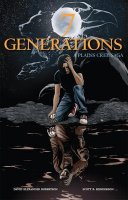I have found a fantastic literary resource, best-suited for HS students studying the history and culture of Canada’s First Nations. David Alexander Robertson, a Cree writer, has developed a series of best-selling graphic novels. What is so important about his works is that they focus specifically on educating youth about indigenous history and contemporary issues. David advocates for First Nations People through the education of today’s youth, weaving his message about social change into his written work, as well as during his speaking engagements. Since the series is written from the author’s first-hand experience, we as educators can be sure that the information and emotions that are being described are accurate portrayals. For more information about David A. Robertson, click here. You can also listen to the author speak about his work at the following CBC radio interview.
Robertson’s most well-known series is called 7 Generations. The series’ main character is an Aboriginal youth named Edwin. The series walks readers through 7 past generations as Edwin, who lives in the present, tries to make terms with what his ancestors had to survive in throughout Canada’s history. Wow. As an educator, I can envision myself using this text to evoke discussions on how our past can shape our present and our future. Students can be encouraged to make connections to this idea – have their ancestors experienced prejudice? Have they themselves experienced any form of prejudice in the past? How has this impacted their self-esteem? This discussion will transition nicely into how today’s indigenous youth are impacted by their peoples’ history. Before sharing these graphic novels with your class, it would be best to pre-read the book and consider whether your students are mature enough to handle to heavy topics being explored (alcoholism, abuse, suicide). I would only recommend these texts for students in High School or older.

